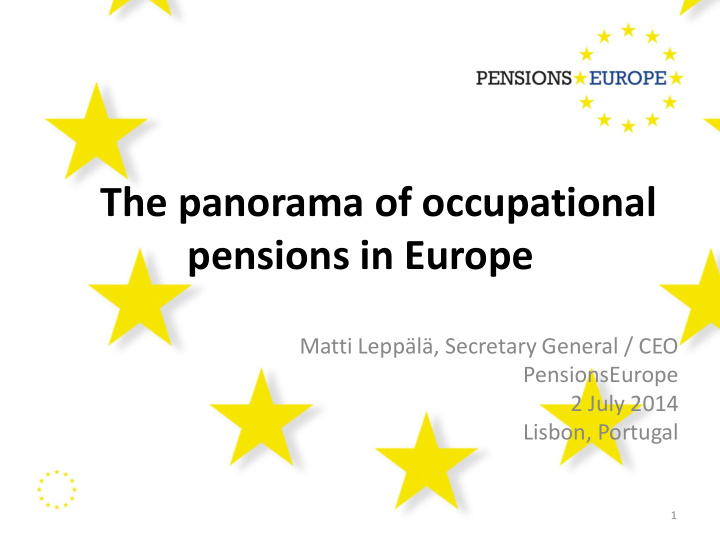



The panorama of occupational pensions in Europe Matti Leppälä, Secretary General / CEO PensionsEurope 2 July 2014 Lisbon, Portugal 1
EU is facing demographic challenges 2
Consequences Reduction first pillar pensions till 2060 (compared to 2010) • Old age dependency will roughly UK Cyprus Hungary double Ireland Denmark Czech Republic • In 2010 there were 4 people of Lithuania Bulgaria France working age for each person 65 Portugal Malta Germany years or older, in 2060 there will Italy Finland only be 2 Estonia EU-27 Austria • Replacement rates will decrease Spain Luxemburg Sweden when not reforming the pension Slovakia Greece Poland system -60 -50 -40 -30 -20 -10 0 10 20 30 40 % Source: European Commission (2012) 3
Old-age poverty rates Percentage of aged over 65 with income less than 50% of median household disposable income Source: OECD, 2011 20 15 10 5 0 NL UK PT 4
European Pensions Landscape • Large public pensions, less funding • France, Spain and Greece • Reforms of 1 st pillar into NDC (mandatory) • Hungary, Poland and Sweden • Some shift from public to private pensions (voluntary) • Germany, Italy and Belgium • Already developed 2 nd pillar, a lot of pension savings • Netherlands, Denmark, Ireland, Switzerland and UK
Pay as you go not sustainable • Important to start promoting complementary funded pension system; “pay as you go” system alone is not enough. • “Complementary retirement savings can also help secure adequate replacement rates in the future. Some Member States have introduced pension funds to complement their public pay- as-you-go pension schemes with private funded schemes , but there is much scope for further development of complementary pension savings opportunities in many Member States .” – White paper on adequate, safe and sustainable pensions, European Commission, 2012. • Differences within the EU: Pension fund assets as percentage of GDP – Portugal 8,8% – United Kingdom 95,7% – The Netherlands 160,2% 6
Pension funds in relation to the economy As % of the GDP Source: OECD Pension Markets in Focus 2013
savings 2nd pillar Link between 1st pillar pensions and pension 100 120 140 160 20 40 60 80 0 Iceland Estonia Slovak Republic Poland Denmark Ireland Netherlands United Kingdom Switzerland Sweden Germany Belgium Hungary Norway GDP) Assets Pension Funds (% Pension (Median Earner) Net Replacement Rate Public France Czech Republic Portugal Finland Slovenia Italy Austria Spain Luxembourg Greece 8
EU: Country Specific Recommendations for Portugal 2014 – “Salary and pension cuts have been implemented in a progressive way, ensuring the protection of lower income earners and lower pensions .” – “Continued restructuring of state owned enterprises, ensuring their financial sustainability and tightly controlling pension and healthcare expenditure will be crucial .” - “Develop a durable solution to ensure the medium-term sustainability of the pensions system by the end of 2014 .” 9
Important for pension funds • Economies of scale in governance, administration and asset management • Risk pooling • Sufficient contribution rates, often employers contribute • Mandatory or semi-mandatory participation • Policies that enable sufficient contributions and good investment returns • Governance and alignment of interest due to participation of the main stakeholders 10
Pension trends across Europe • Increase in number of DC schemes • More focus on risk management, governance and disclosure • Central issues (both DB and DC): how to deal with volatile financial markets
Global comparisons: MERCER GLOBAL PENSION INDEX Mercer Index measures - Adequacy - Sustainability and - Integrity Denmark scores the highest e.g. because - High benefit level - High replacement rate - Full vesting of rights - High coverage - High level of private pension funding (in relation to GDP) - High level of contributions - High requirements in supervision, reporting, governance - Government can formulate policies 12 Source: Melbourne Mercer Global Pension Index 2013
Global comparisons: GLOBAL AGING PREPAREDNESS INDEX • Essential to find a balance between Fiscal Sustainability and Income Adequacy • For countries in the middle in both indicators some things in common: • reasonable fertility rates, • lean public pensions (i.e. reformed), • mandated second pillar and • good labor force participation rates. Source of the picture: GAP Index, Jackson, Howe, Nakashima, CSIS 2010 13
Prerequisites for a good pension system • Prerequisites for all pension systems: “Effective central government, fiscal stability, economic growth, well- established financial markets, and adequate public and government understanding of and trust in them” ( Barr 2002 ) • “There can be no sound development of funded pensions without real economic growth “( Holzman 2012 ). 14
Reform in the Netherlands: Improve economies of scale • The Netherlands wanted to increase the economies of scale of pension funds to decrease the costs ie increase the pension benefits. • Pension funds in the Netherlands decreased from 1100 to 375 since 2010. • Costs have decreased since, the bigger the fund the smaller the costs. 15 Source for the picture: Administrative costs, Pensioenfederatie 2011
Conclusion • First pillar pension will be reduced • “Pay as you go” not sustainable • More workplace pensions needed for adequate and sustainable pensions • More funded pensions are needed 16
CONTACTS Matti Leppälä, Secretary General/CEO PensionsEurope Koningsstraat 97 Rue Royale 1000 Brussels Tel.: +32 2 289 14 14 Fax: +32 2 289 14 15 www.pensionseurope.eu
Recommend
More recommend